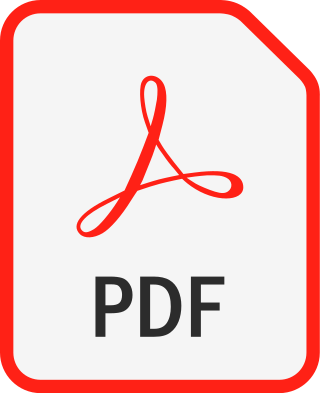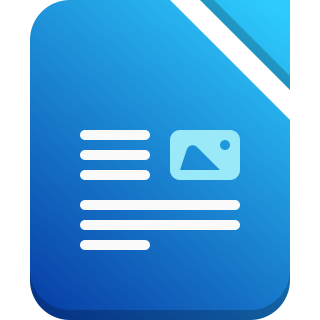Pretty Good Privacy (PGP) is an encryption program that provides cryptographic privacy and authentication for data communication. PGP is used for signing, encrypting, and decrypting texts, e-mails, files, directories, and whole disk partitions and to increase the security of e-mail communications. Phil Zimmermann developed PGP in 1991.

Portable Document Format (PDF), standardized as ISO 32000, is a file format developed by Adobe in 1992 to present documents, including text formatting and images, in a manner independent of application software, hardware, and operating systems. Based on the PostScript language, each PDF file encapsulates a complete description of a fixed-layout flat document, including the text, fonts, vector graphics, raster images and other information needed to display it. PDF has its roots in "The Camelot Project" initiated by Adobe co-founder John Warnock in 1991. PDF was standardized as ISO 32000 in 2008. The last edition as ISO 32000-2:2020 was published in December 2020.

John the Ripper is a free password cracking software tool. Originally developed for the Unix operating system, it can run on fifteen different platforms. It is among the most frequently used password testing and breaking programs as it combines a number of password crackers into one package, autodetects password hash types, and includes a customizable cracker. It can be run against various encrypted password formats including several crypt password hash types most commonly found on various Unix versions, Kerberos AFS, and Windows NT/2000/XP/2003 LM hash. Additional modules have extended its ability to include MD4-based password hashes and passwords stored in LDAP, MySQL, and others.

The Bat! is an email client for the Microsoft Windows operating system, developed by Moldovan software company Ritlabs. It is sold as shareware and offered in three editions: Home Edition, Professional Edition, and Voyager which is a portable version and is included with Professional Edition.

PhpGedView is a free PHP-based web application for working with genealogy data on the Internet. The project was founded and is headed by John Finlay. It is licensed under the GPL-2.0-or-later license.
In computing, a Personal Storage Table (.pst) is an open proprietary file format used to store copies of messages, calendar events, and other items within Microsoft software such as Microsoft Exchange Client, Windows Messaging, and Microsoft Outlook. The open format is controlled by Microsoft who provide free specifications and free irrevocable technology licensing.
The Extensible Metadata Platform (XMP) is an ISO standard, originally created by Adobe Systems Inc., for the creation, processing and interchange of standardized and custom metadata for digital documents and data sets.
In cryptography, key stretching techniques are used to make a possibly weak key, typically a password or passphrase, more secure against a brute-force attack by increasing the resources it takes to test each possible key. Passwords or passphrases created by humans are often short or predictable enough to allow password cracking, and key stretching is intended to make such attacks more difficult by complicating a basic step of trying a single password candidate. Key stretching also improves security in some real-world applications where the key length has been constrained, by mimicking a longer key length from the perspective of a brute-force attacker.
A password manager is a computer program that allows users to store and manage their passwords for local applications or online services such as web applications, online shops or social media. A web browser generally has a built in version of a password manager. These have been criticised frequently as many have stored the passwords in plaintext, allowing hacking attempts.

PeaZip is a free and open-source file manager and file archiver for Microsoft Windows, ReactOS, Linux, MacOS and BSD by Giorgio Tani. It supports its native PEA archive format and other mainstream formats, with special focus on handling open formats. Version 9.4.0 supported 234 file extensions.

KDE Wallet Manager (KWallet) is free and open-source password management software written in C++ for UNIX-style operating systems. KDE Wallet Manager runs on a Linux-based OS and Its main feature is storing encrypted passwords in KDE Wallets. The main feature of KDE wallet manager (KWallet) is to collect user's credentials such as passwords or IDs and encrypt them through Blowfish symmetric block cipher algorithm or GNU Privacy Guard encryption.
AllMyNotes Organizer is an outliner application for Windows. It allows you to store all documents and notes in a single storage file. Documents are organized in a hierarchical tree representation for quick browsing by topic. A portable version which can be installed on a USB flashdrive, iPod, or removable hard disk drive which can be used on any PC without the need to be installed is also available.
Xena is open-source software for use in digital preservation. Xena is short for XML Electronic Normalising for Archives.

KeePass Password Safe is a free and open-source password manager primarily for Windows. It officially supports macOS and Linux operating systems through the use of Mono. Additionally, there are several unofficial ports for Windows Phone, Android, iOS, and BlackBerry devices, which normally work with the same copied or shared (remote) password database. KeePass stores usernames, passwords, and other fields, including free-form notes and file attachments, in an encrypted file. This file can be protected by any combination of a master password, a key file, and the current Windows account details. By default, the KeePass database is stored on a local file system.

LibreOffice Writer is the free and open-source word processor and desktop publishing component of the LibreOffice software package and is a fork of OpenOffice.org Writer. Writer is a word processor similar to Microsoft Word and Corel's WordPerfect with many similar features, and file format compatibility.
crypt is a POSIX C library function. It is typically used to compute the hash of user account passwords. The function outputs a text string which also encodes the salt, and identifies the hash algorithm used. This output string forms a password record, which is usually stored in a text file.

BeerXML is a free, fully defined XML data description standard designed for the exchange of beer brewing recipes and other brewing data. Tables of recipes as well as other records such as hop schedules and malt bills can be represented using BeerXML for use by brewing software.

Pleasant Password Server is a proprietary, multi-user enterprise password server that is fully compatible with a modified version of the KeePass Password Safe. Designed for business users, the password server provides access provisioning as well as per-group and per-entry access restrictions. Pleasant Password Server supports the use of secure passwords, allowing system administrators to manage user passwords from a central web interface.

VeraCrypt is a free and open-source utility for on-the-fly encryption (OTFE). The software can create a virtual encrypted disk that works just like a regular disk but within a file. It can also encrypt a partition or the entire storage device with pre-boot authentication.









